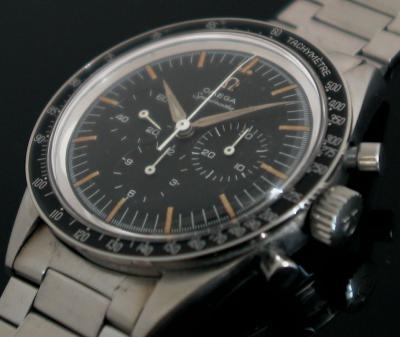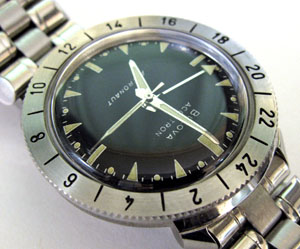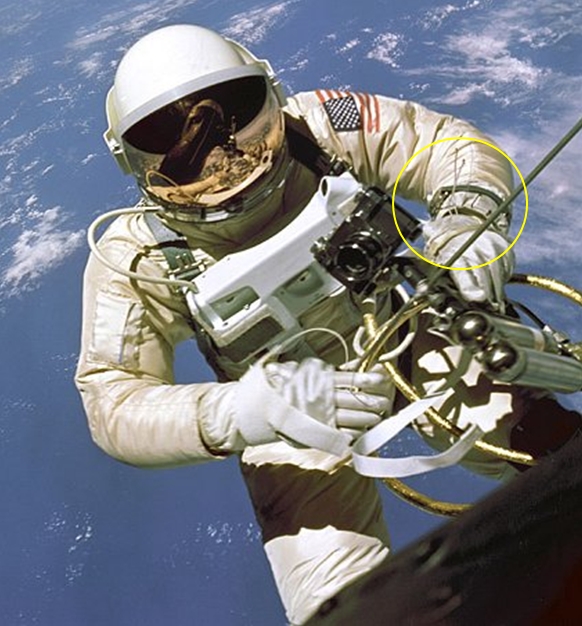Watches in Space - 4 : Omega begins its adventure...
(continuation of Watches in Space - 3 : Beginning of the adventure, on US side.)
French version: Les montres dans l'espace - 4 : Omega, le début de l'aventure.
An almost clandestine passenger

The fifth american to jump into space had been Walter « Wally » Schirra, on the 3rd of october, 1962, on board of Sigma7, for a 9 orbit flight that lasted a bit more than 9 hours. He took with him his personnal Omega Speedmaster, model 2998 (the second generation of Speedmaster, caliber Omega 321).
This was the first Omega in space.

Then, for the las Mercury mission, th e15th of may, 1963, Gordon Cooper took with him in his ship Faith 7, for the first mission that lasted more than 1 day (1 day and 10 hours, for 22 orbits), a Speedmaaster and a Bulova Accutron Astronaute (electronic watch, see Breitling Navitimer Cosmonaute: étrange ce nom? to be translated), to compare their time accuracy.
The selectin by NASA
NASA was already at the end of the Mercury program, with a lonely passenger on board, and was beginning to prepare the Gemini program (launched in december 1961 under the "Mercury mark II" denomination, and renammed simply "Gemini" in january 1962), that allowed to send 2 men, then Apollo to send 3 men. Those 2 new programs had also to allow extra-vehicule exits, hence with very severe environmental conditions, not talking about the conditions the moon, ultimate target of Apollo program.
Mechanical watches, that were until now only used to ompensate a potential failure of an electric equipment, had to go outside the ship and become fully a time indication device. Serious tests were necessary...
So, in 1964, Donald K. Slayton, at that time responsible for Crewed Flight Operations in NASA, asked to buy, secretly, at Corrigan's, a famous watch seller in Houston, Texas, many chronographs:
|
|
Among those watches, only the last 3 (Omega, Rolex and Longines) had been choosen to support tests. So on the 29th of september 1964, NASA ordered, among others, many watches to Omega, in custommer configuration.
The tests
Test started on the 21st of october 1964, and finished on the 1st of march 1965. Between those 3 watchs:
- Rolex failed two times in relativ humidity test, then stopped totally during the heat resistance test, becase the second hand wraped around the two others.
- On the Longines, during the Heat Resistance test, the glass started to melt and felt from the case. Another model met the sam probel during the decompression test.
- The Omega had been the one ith the most satisfactory behaviour, even if not perfect: it gained 21 minutes during the decompression test, and lost 15 minutes during the acceleration test. At the end of the tests, the dial was not luminous anymore.
The result of the tests had been officialised by:
- An intern note: "The operationnals and environmental tests on 3 chronographs are now finished. After those tests, the Omega Chronographs had been calibrated and distributed to the three member of the crew GT-3 (Gemini Titan 3)".
- A communication: « … the astronautes are showing a unanimous preference for the Omega Chronograph, compared to the two other brands because its higher accuracy, its higher reliability, and its easier operationnality.»
The beginnings of the official adventure
The first two Gemini flight were inhabited and served as technical tests for atmosphere entrance, and other elements (Gemini 1 the 4th april, 1964, and Gemini 2 the 19th january, 1965).
The 3rd Gemini flight had been the first manned one, piloted by Gus Grissom and John Young, the 23rd of march, 1965. So they were the first to carry officially an Omega Speedmaster. In fact most of the astronautes were taking two with them: on the the Elapsed Mission Time) and one set on the GMT (or Houston time).
During the 4th Geminiflight, between 3rd and 7th of june, 1965, piloted by James McDivitt and Edward White, White made the first american Extra-Vehicule Exit, and the Omega he was carrying (model 105.003) was also the first watch to meet the spatial vaccuum. (The Soviet Alexei Leonov had made the first human Extra-Vehicule Exit of the history, on the 18th of march 1965, but he was carrying his watch INSIDE his Flight-suit)

Ed Whitetested also the first autonomous propulsion system (a little air gun). The watch allowed him to mesure the duration of his exit, and also the duration of his gun usage. Totally euphoric, he had difficulties to come back in the capsule and only do so when firmly ordered, saying that it was the sadest moment of his life! Those 21 minutes at an altitude of 180 kilometers, and at 27 000 km/h entered the History.

It is when seeing the photo cover of LIFE of the 18th of june, 1965, that Omega learned the spatial adventure of their watch. So they begun to use it as a marketing argument, and added "Professiona" on the dial.
Continuation: Watches in Space - 5 : Omega Big Time
Back to introduction: Watches in Space - 1 : Introduction.
A découvrir aussi
- Watches in Space - 7 : Continuation ... and end?
- Smart Watches vs. Mechanical Watches
- Dewitt and Napoleon
Inscrivez-vous au blog
Soyez prévenu par email des prochaines mises à jour
Rejoignez les 25 autres membres
